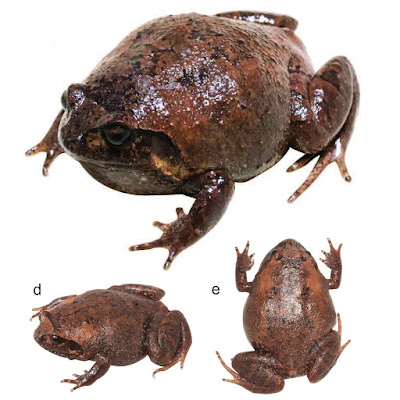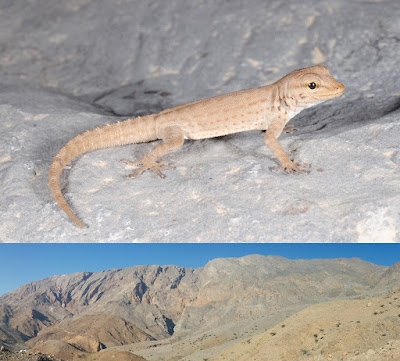 |
| Rhombophryne nilevina Lambert, Hutter & Scherz, 2017 DOI: 10.3897/zse.93.10188 |
Abstract
We describe a new species from the cophyline microhylid genus Rhombophryne, a group of fossorial and terrestrial frogs endemic to Madagascar. Found during herpetofaunal surveys of moist montane forest in the remote north of Ranomafana National Park, Rhombophryne nilevina sp. n. exemplifies two difficulties that hinder taxonomic progress in Malagasy cophyline frogs: micro-endemicity and highly secretive habits. Known from only two adult male specimens, this new species is nonetheless easily distinguishable from all other known Rhombophryne using morphological data, and osteological data collected here via X-ray Micro-Computed Tomography, or " micro-CT ". This species is now the largest known Rhombophryne, and the only one known from Ranomafana National Park, which will make it the southern-most member of the genus pending a forthcoming taxonomic revision involving Plethodontohyla and Rhombophryne. Pairwise distances of the mitochondrial 16s rRNA marker show a minimum genetic distance of 4.9% from other nominal Rhombophryne. We also describe recordings of an advertisement call, emitted from a burrow by the holotype. Rhombophryne nilevina sp. n. is not known to be found syntopically with other Rhombophryne, nor to be present elsewhere in Ranomafana National Park, but it probably does co-occur with a few ecologically similar Plethodontohyla species. Although the type locality is within a protected area, we suggest an IUCN listing of Data Deficient for R. nilevina sp. n., as its area of occupancy is largely undetermined within the park.
Key Words: Amphibia, Anura, Microhylidae, Rhombophryne nilevina, taxonomy, osteology, micro-CT, endemicity, herpetology
Rhombophryne nilevina sp. n.
Suggested common English name: Buried Diamond Frog
Suggested common Malagasy name: Sahona diamondra nilevina
Suggested common French name: La grenouille de diamant enterré
Diagnosis: A frog assigned to the cophyline genus Rhombophryne on the basis of its divided vomer, the possession of clavicles and knob-shaped terminal phalanges (see Scherz et al. 2016a). This species is characterized by the following suite of characters: large size (SVL at least up to 57.2 mm), wide, short head (HW 180.7% of HL), tympanum 58.6% of eye, forelimb 51.1% of SVL, tibia 42.2% of SVL, hindlimb 152.5% of SVL, large inner metacarpal and metatarsal tubercles, supratympanic fold distinct and raised, running from the posterior corner of the eye straight over the tympanum, then sharply down behind it, extending to join the front of the arm, distinct vomerine teeth forming curved rows posteromedial to the oblong choanae, separated medially by a small cleft, second finger shorter than fourth finger, fifth toe distinctly shorter than third, without finger or toe reduction, finger and toe tips not enlarged. Additionally, R. nilevina is separated from all nominal species of Rhombophryne by an uncorrected pairwise distance of at least 4.9% in the fragment of the 16S rRNA gene, and by at least 3.8% from all known candidate species in this genus.
......
Etymology: The specific epithet “nilevina” is a Malagasy word meaning “buried.” This name was chosen to recognize the fossorial habits of this species. It is to be treated as an invariable noun in apposition.
Natural history. Both known specimens of R. nilevina were obtained from a relatively flat, poorly drained section of moist montane forest adjacent to a stream, with the holotype found along the bank of this stream. Nearby habitats include a swamp with many large Pandanus and steep forested slopes with relatively smaller trees. However, the calls of R. nilevina seemed to emanate mostly from the flatter, forested area. Males were heard calling during the day, particularly during overcast conditions and after rainfall. Advertisement calls were not heard at night, however, the night-time chorus of other frogs, including Boophis, Spinomantis, Gephyromantis, and Anodonthyla, may have interfered with detection. When heard from a distance, the call is reminiscent of that of an owl. When heard from close proximity, the call sounds like a groan, and is far less melodic. Both specimens were both located by auditory tracking, and found calling from underground: one from a cavity under the roots of a large tree, and the other from a burrow in soft, moist soil alongside the stream. In order to collect the holotype from its burrow, excavation was required. Based on these observations and suggestive morphology, we presume that R. nilevina spend much of their lives underground, possibly coming to the surface for short periods during rainfall, similar to other fossorial Rhombophryne species (Glaw and Vences 2007, D’Cruze et al. 2010). We also note that R. nilevina was discovered in the middle of the wet season, and after a week-long period of particularly heavy, sustained rain.
Distribution: Rhombophryne nilevina has thus far been detected at a single site, near the former village of Andemaka, in the north-west of Ranomafana National Park (Fig. 2). This locality is relatively high-elevation for Ranomafana National Park (ca. 1240 m). To our knowledge, R. nilevina has not been detected by any previous survey, including several conducted by CRH and SML at similarly high-elevation sites in the northern (Miaranony), central (Vohiparara), and southern (Maharira) regions of Ranomafana. Nevertheless, we do not rule out here the possibility that R. nilevina occurs elsewhere in the park. This is in large part due to the secretive habits and potentially ephemeral activity periods of this species (see Natural history). In addition, much of the high-elevation forest of Ranomafana is difficult to access and thus remains sparsely or completely unsurveyed for herpetofauna. Although it is possible that R. nilevina has been overlooked in other eastern rainforest patches, current information suggests that this species is endemic to Ranomafana National Park, and potentially to a much smaller area within the park.
Shea M Lambert, Carl R. Hutter and Mark David Scherz. 2017. Diamond in the Rough: A New Species of Fossorial Diamond Frog (Rhombophryne) from Ranomafana National Park, southeastern Madagascar. Zoosystematics and Evolution. 93(1); 143–155. DOI: 10.3897/zse.93.10188
Diamond in the rough: meet Madagascar's fat new frog
http://www.markscherz.com/archives/3147 via @MarkScherz
http://www.markscherz.com/archives/3147 via @MarkScherz




























































